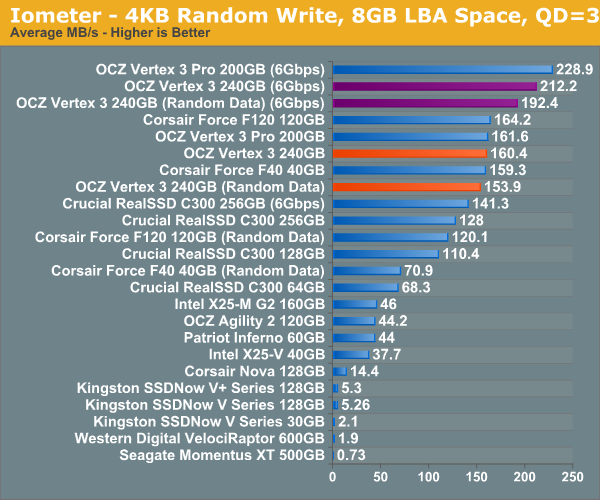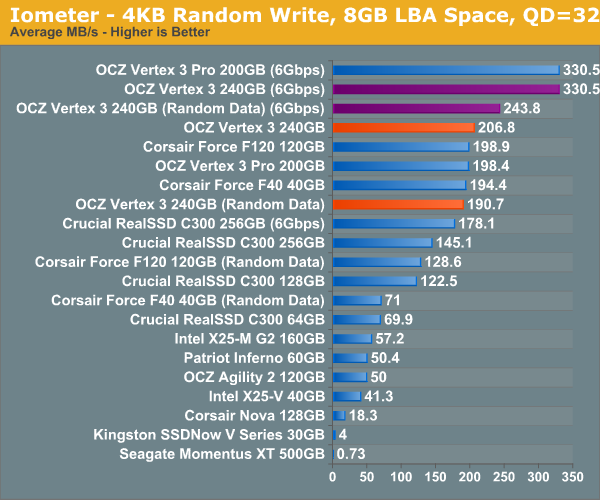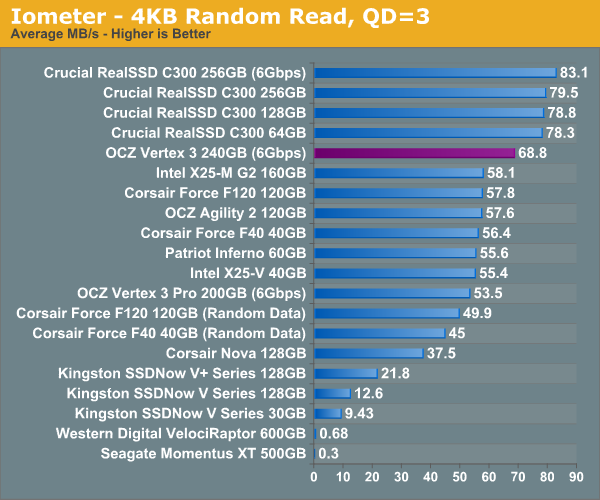OCZ Vertex 3 Preview: Faster and Cheaper than the Vertex 3 Pro
by Anand Lal Shimpi on February 24, 2011 9:02 AM ESTRandom Read/Write Speed
The four corners of SSD performance are as follows: random read, random write, sequential read and sequential write speed. Random accesses are generally small in size, while sequential accesses tend to be larger and thus we have the four Iometer tests we use in all of our reviews.
Our first test writes 4KB in a completely random pattern over an 8GB space of the drive to simulate the sort of random access that you'd see on an OS drive (even this is more stressful than a normal desktop user would see). I perform three concurrent IOs and run the test for 3 minutes. The results reported are in average MB/s over the entire time. We use both standard pseudo randomly generated data for each write as well as fully random data to show you both the maximum and minimum performance offered by SandForce based drives in these tests. The average performance of SF drives will likely be somewhere in between the two values for each drive you see in the graphs. For an understanding of why this matters, read our original SandForce article.

Many of you have asked for random write performance at higher queue depths. What I have below is our 4KB random write test performed at a queue depth of 32 instead of 3. While the vast majority of desktop usage models experience queue depths of 0 - 5, higher depths are possible in heavy I/O (and multi-user) workloads:












85 Comments
View All Comments
FunBunny2 - Thursday, February 24, 2011 - link
Well, no custom firmware, just a custom controller. Intel had the first really good pro-sumer controller. Likely still does.bhougha10 - Thursday, February 24, 2011 - link
Anand,can you give us an idea when the intel G3 will be comming out so we have an idea wait the field looks like here. Intel seems to keep this stuff very secret :(
mckirkus - Thursday, February 24, 2011 - link
510 Series from Intel launching March 1 if you believe the rumors. Sata 6Gb/s but using 34nm flash. Just over $2/GB. Seems like it has low IOPS compared to other SSDs but real world performance is TBD.I'd bet a dollar Anand is working on a review of one right now. I'm using a 1st gen Sandforce drive and it's so damn fast I'm not sure I'll ever need to upgrade the thing.
iwod - Friday, February 25, 2011 - link
Not a Rumors, someone from Taiwan already has their hands on it.It uses an Marvel Chipset.
At this moment we are still not sure if 510 series means G3.
JonnyBlaze - Thursday, February 24, 2011 - link
Not a bad idea.lorteti - Thursday, February 24, 2011 - link
Hi Anand,How about a power consumption test.
For those that want to use the Vertex3 in a notebook.
Thanks,
jx
JFish222 - Sunday, February 27, 2011 - link
Hi Anand,I'd like to second this request.
I'd love to throw one of these into my laptop, but I'm always looking to balance performance with battery life (the old T61 is getting long in the tooth and an SSD sounds like a perfect upgrade!)
All of the recommendations to add SSD's to "netbook class units" (atom and Brazos) adds to this conversation. Though netbooks are popular due to their low price, their portability and battery life (which one could argue are one and the same) are also selling points.
Thanks again for the great review, and I'm looking forward to your future investigations into the OCZ debacle. Journalism has always been about both informing and inciting change. Anandtech remains the only site on the net that I've found that has the reach to do both.
Thanks again,
Jordan
MarcHFR - Thursday, February 24, 2011 - link
Dear all, Dear Anand,I think it's important to note that AnandTech Storage Bench, like PC Mark Vantage HDD, represent a "best case" for SandForce based SSD.
These benchmarks are based on logs which have recorded accesses to be repeated, but not the data contained in these accesses. These means that the data used in the benchmark may well be highly compressible, which isn’t necessarily the case in real usage.
Am i wrong ?
Chloiber - Thursday, February 24, 2011 - link
I wanted to ask the same thing in the Vertex 3 Pro test. Would be nice to have an answer here. I don't think that the data is random.jwilliams4200 - Thursday, February 24, 2011 - link
I've also wondered about that. Does the 2011 Storage Bench that writes 100+ GB of data have a 100+ GB data file? If so, how much does that data file compress when run through a zip or 7zip compression program?If not, if the data file is much smaller than 100 GB, then exactly what is being written to the drives?